14 min reading time
What Are Maintenance Support Processes?
5 พ.ย. 2022, 9:09:43

Maintenance managers are struggling with the execution of the maintenance strategy and failing to achieve the maintenance goals and objectives set by the company's management often due to the lack of a maintenance process so they should develop first a Manage Maintenance Process and the Realization Processes and then Support Processes to complete the development of The Maintenance Process of the company.
Support ProcesSes
What Are Maintenance Support Processes?
The European EN 17007:2017 standard describes support processes as follows:
"Support processes are essential to the functioning of other processes such as the management process, realization processes, and other support processes as they provide them with the necessary resources."
There are eleven support processes which are necessary for The Maintenance Process of the company:
- HSE = Ensure personal health and safety to individuals and preserve environment in maintenance;
- BUD = Budget maintenance items;
- DOC = Deliver the operational documentation;
- DTA = Manage data;
- ENG = Deliver maintenance requirements during items design and modification;
- OPT = Improve the results;
- TOL = Deliver the tools, support equipment and information system;
- SPP = Deliver spare parts;
- RES = Provide internal human resources;
- SER = Provide maintenance services; and
- IST = Provide the needed infrastructures.
SOURCE: EN17007 Maintenance process and associated indicators
THE HSE PROCESS
According to the European EN 17007:2017 standard the purpose of The HSE Process is to:
"Ensure personal health and safety and protect the property, plant, and equipment as well as the environment during the execution of maintenance tasks.
Maintenance management should: evaluate the risks related to the execution of maintenance tasks; define measures for preventing accidents and responding to incidents; and develop a prevention and safety plan for maintenance.
Ensure personal health and safety to individuals and preserve environment in maintenance (HSE) process has five elementary processes: Prepare the risk assessment; Identify risks; Prioritize risks; and Propose measures for preventing risks and consequences of identified risks; as well as Monitor risk management.
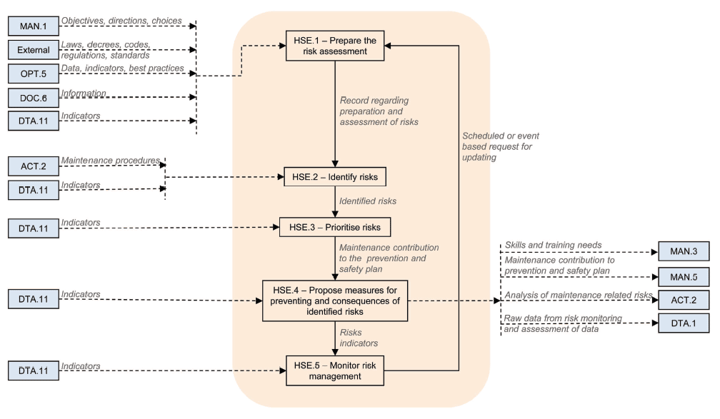
PHOTO: The HSE Process
SOURCE: EN17007 Maintenance process and associated indicators
THE BUD PROCESS
According to the European EN 17007:2017 standard the purpose of The BUD Process is to:
"Schedule short, medium, and long-term economic planning, based on a defined cycle, for regular maintenance and exceptional maintenance (investment) activities."
Maintenance management should structure budget information, by cost allocation categories, to ensure that it is monitored, checked, and managed over time.
Budget maintenance items (BUD) process has five elementary processes: Define and compile cost elements and estimate or calculate actual costs; Create a budget estimate for regular maintenance; Create a budget estimate for infrequent or exceptional maintenance tasks; and Extract budgeted and actual expenditures; as well as Analyze, explain, and take corrective actions, if applicable.
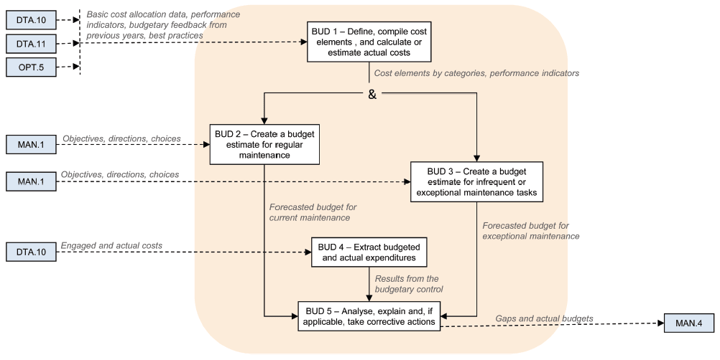
PHOTO: The BUD Process
SOURCE: EN17007 Maintenance process and associated indicators
THE DOC PROCESS
According to the European EN 17007:2017 standard the purpose of The DOC Process is to:
"Provide all those concerned, at the place of use, with all the up-to-date and usable documents they need to prepare for and perform the tasks for which they are responsible while optimizing logistic times."
Maintenance management should use a maintenance information management system and structure maintenance information, by information categories, to ensure that information is analyzed, updated, and managed over time.
Deliver the operational documentation (DOC) process has six elementary processes: Define and manage rights to the documentation; Classify and structure the documentation; Compile the reference documentation; Update the reference documentation; and Ensure access to necessary information at all times; as well as Manage the way in which operational documentation is made available.
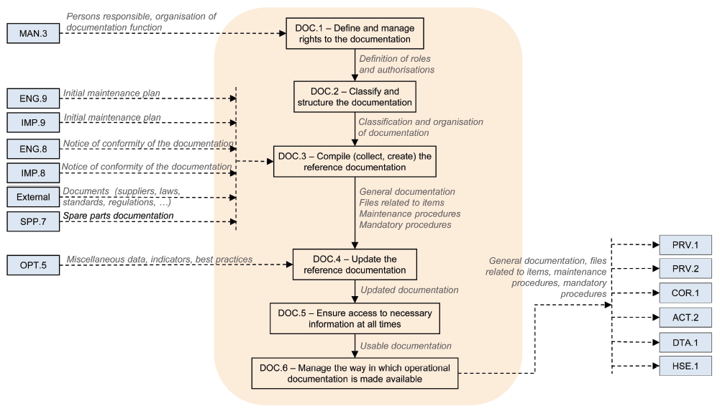
PHOTO: The DOC Process
SOURCE: EN17007 Maintenance process and associated indicators
THE DTA PROCESS
According to the European EN 17007:2017 standard the purpose of The DTA Process is to:
"Collect, analyze, store, and transmit all data needed to document and improve The Maintenance Process."
Maintenance management should use a maintenance information management system to ensure that information is collected, analyzed, stored, transmitted, and managed over time.
Manage data (DTA) process has eleven elementary processes: Store and validate the raw data in a library or database; Evaluate the reliability and maintainability of the items by maintaining an actual state assessment of the items; Draw up and maintain an up-to-date list of critical items; Evaluate and analyze maintenance data and HSE data; Evaluate and analyze data related to spare parts; Evaluate and analyze cases of known or predictable obsolescence; Collect and analyze events at other organizations; Compare maintenance practices and materials used by other operators or recommended by suppliers; Monitor methods, technologies, regulations, standards, etc.; and Save and provide access to data in a data processing system; as well as Calculate, save, and provide access to performance and monitoring indicators.
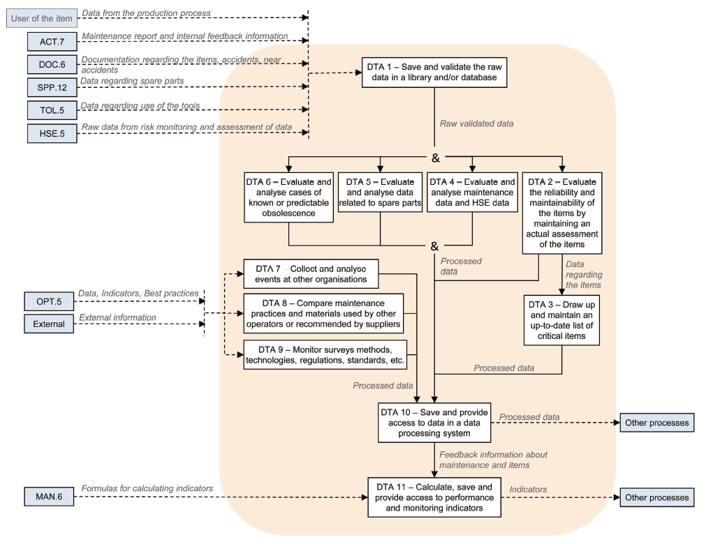
PHOTO: The DTA Process
SOURCE: EN17007 Maintenance process and associated indicators
THE ENG PROCESS
According to the European EN 17007:2017 standard the purpose of The ENG Process is to:
"Define, monitor or realize and valuate item investments and modifications when the operational objectives are no longer reachable or have been changed."
Maintenance management should define the initial reliability, maintainability, and maintenance support requirements, maintenance plans, the maintenance providers' related skills and the various logistical resources such as hardware, documentation, and spare parts needed to implement the maintenance plan on these items.
Deliver maintenance requirements during items design and modification (ENG) process has eleven elementary processes: Collect feedback data; Perform risk analyses; Develop reliability, maintainability, and logistic support requirements; Oversee or contribute to the drafting of specifications; Issue an invitation to tender suppliers; Participate in the analysis and choice of options and validate the solutions; Follow up realization; Verify conformity with the reliability, maintainability, and logistic support requirements; Establish the initial maintenance plan; and Determine the initial logistical resources; as well as Identify skills and training needs.
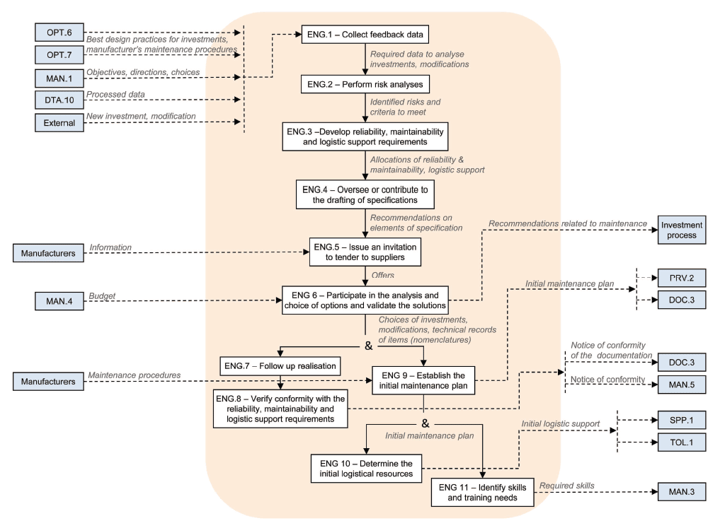
PHOTO: The ENG Process
SOURCE: EN17007 Maintenance process and associated indicators
THE OPT PROCESS
According to the European EN 17007:2017 standard the purpose of The OPT Process is to:
"Represent a part of continuous improvement loop which analyzes the internal and external feedback data to determine actions to be taken, targets to be achieved and best practices to be applied for each of the processes."
Maintenance management should define the initial reliability, maintainability, and maintenance support requirements, maintenance plans, the maintenance providers' related skills and the various logistical resources such as hardware, documentation, and spare parts needed to implement the maintenance plan on these items.
Improve the results (OPT) process has seven elementary processes: Determine the areas of improvement; Prioritize areas of improvement related to The IMP Process; Prioritize areas of improvement related to The MAN Process; Prioritize areas of improvement related to The BUD, DOC, DTA, TOL, SPP, RES, IST, and HSE Processes; and Prioritize and specify modifications of existing items (The ENG Process); as well as Prioritize improvements for future investments (The ENG Process).
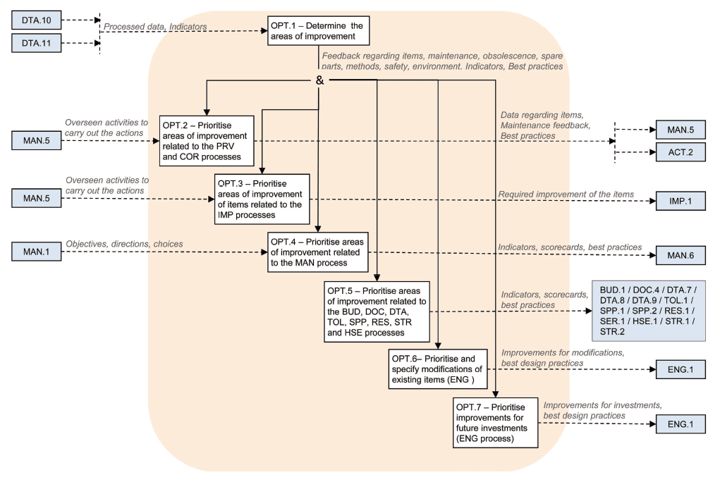
PHOTO: The OPT Process
SOURCE: EN17007 Maintenance process and associated indicators
THE TOL PROCESS
According to the European EN 17007:2017 standard the purpose of The TOL Process is to:
"Provide users with the operational technical resources needed for maintenance such as conventional and specialized tools, test, handling and other equipment, and information and maintenance management systems."
Maintenance management should consider using a computerized maintenance management system to manage the internal lending and storage of tools and test, handling and other equipment as well as information needed for the execution of maintenance tasks such as user manuals and maintenance instructions, for example.
Deliver the tools, support equipment and information system (TOL) process has six elementary processes: Determine and provide the support equipment needed for maintenance; Store the support tools and equipment; Maintain or update the support equipment; Deliver the tools and other support equipment; and Determine and provide a maintenance management, decision support software tools and documentation system; as well as Maintain or update the maintenance documentation system.
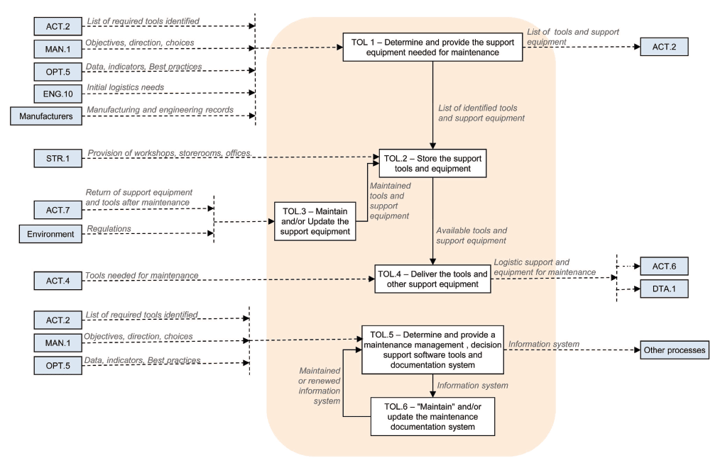
PHOTO: The TOL Process
SOURCE: EN17007 Maintenance process and associated indicators
THE SPP PROCESS
According to the European EN 17007:2017 standard the purpose of The SPP Process is to:
"Provide the maintenance teams with the spare parts, materials, consumables, and other items needed for the maintenance tasks within the required timeframes."
Maintenance management should consider using a computerized maintenance management system or a warehouse management system to manage the inventory items.
Deliver spare parts (SPP) process has twelve elementary processes: Determine the spare items to keep in stock for maintenance; Manage stocks; Reserve or issue a purchase request for spare items; Order spare items from suppliers; Establish and monitor contracts with suppliers; Receive ordered or repaired spare items; Add the spare items to stock; Perform preventive maintenance on spare items in stock; Deliver spare items; and Assess replaced spare items; and Repair spare items; as well as Dispose of faulty or damaged spare items.
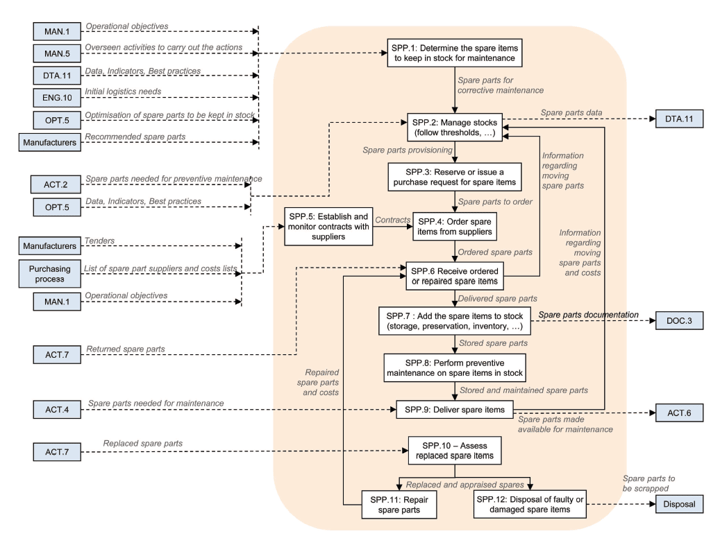
PHOTO: The SPP Process
SOURCE: EN17007 Maintenance process and associated indicators
THE RES PROCESS
According to the European EN 17007:2017 standard the purpose of The RES Process is to:
"Provide in a timely manner the internal or external human resources who have the necessary skill levels and certification to perform the maintenance tasks."
Maintenance management should consider using the resources of external companies, when the gap of knowledge, skills, and experience between the internal resources and skills requirements is too wide to close with internal or external training.
Provide internal human resources (RES) process has four elementary processes: Manage jobs and skills; Recruit competent staff; and Ensure training, qualification, and certification of internal staff; as well as Provide internal manpower.
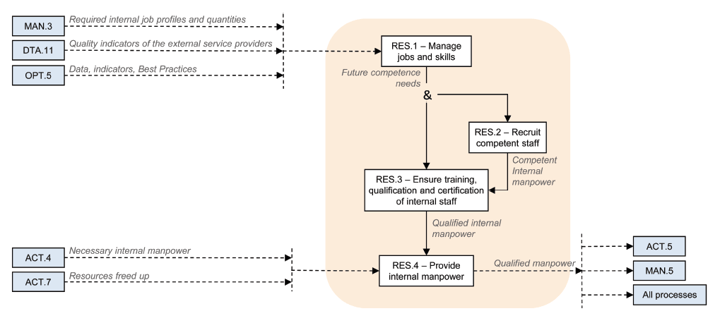
PHOTO: The RES Process
SOURCE: EN17007 Maintenance process and associated indicators
THE SER PROCESS
According to the European EN 17007:2017 standard the purpose of The SER Process is to:
"Provide in a timely manner the maintenance services carried out by external companies and their human resources who have the necessary skill levels and certification to perform the maintenance tasks."
Maintenance management should consider using the resources of external companies, when special knowledge, skills, and experience is required to execute maintenance tasks. Some maintenance tasks such as inspections must be performed by external companies provided with special certifications.
Provide maintenance services (SER) process has four elementary processes: Identify competent external companies; Contract with external companies; and Manage contracts and evaluate companies and services; as well as Provide external services.
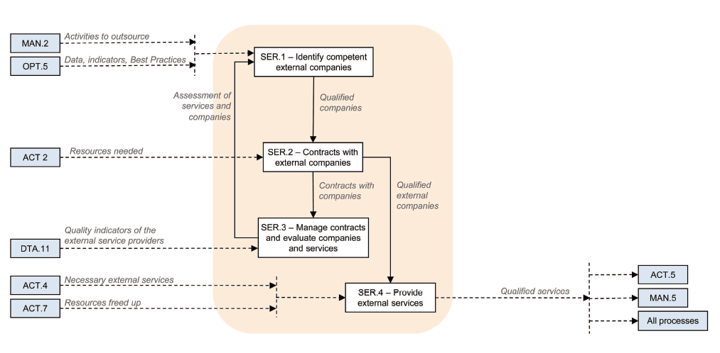
PHOTO: The SER Process
SOURCE: EN17007 Maintenance process and associated indicators
THE IST PROCESS
According to the European EN 17007:2017 standard the purpose of The IST Process is to:
"Provide the infrastructures and facilities that all maintenance personnel need to fully perform their maintenance tasks in a manner that is safe for the individuals, the items, and the environment."
Maintenance management should consider using the resources of external companies, when special knowledge, skills, and experience is required to execute maintenance tasks. Some maintenance tasks such as inspections must be performed by external companies provided with special certifications.
Provide the needed infrastructures (IST) process has three elementary processes: Plan and provide appropriate and safe premises and areas; and Plan and provide the necessary power, utilities, and services; as well as Maintain or update the infrastructures and facilities.
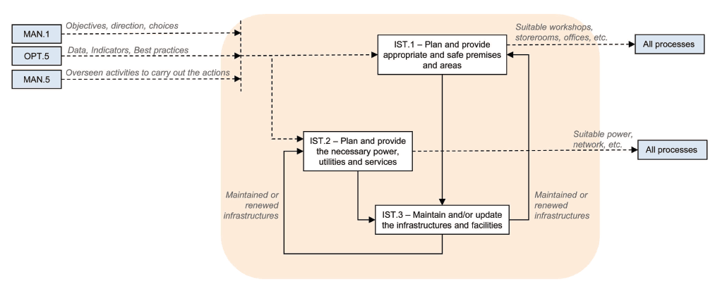
PHOTO: The IST Process
SOURCE: EN17007 Maintenance process and associated indicators
After the development of a Management Process, Realization Processes and Support Processes has been completed by maintenance management, the development of The Maintenance Process has been completed. If you are struggling with the development of Support Processes, don't hesitate to contact us.
We can help.
Maintenance ProcesS
What Is The Maintenance Process?
The Maintenance Process describes how to manage maintenance, prevent undesirable events, restore the items in required state, improve the items, and act on items to maintain them in a good working order. It also describes the support processes which are necessary for the realization and management processes.
The European EN 17007:2017 standard classifies the maintenance process into three main process families:
"A management process that establishes policy and strategy, defines the organization, assigns responsibilities, negotiates budgets, manages actions, analyses data and leads a continuous improvement process."
"Realization processes which are the reason of being the overall process and produce the expected results. They include preventive and corrective maintenance which share a common process including preparation, scheduling, and performing tasks on items, and a third process for improving reliability and maintainability of items."
"Support processes which are necessary for the realization and management processes."
Blog Posts
What Is Maintenance Process?
Maintenance managers are struggling to execute the maintenance strategy and to achieve the...
What Is a Maintenance Management Process?
Maintenance managers are struggling with the execution of the maintenance strategy and to achieve...
What Are Maintenance Realization Processes?
Maintenance managers are struggling with the execution of the maintenance strategy and failing to...

